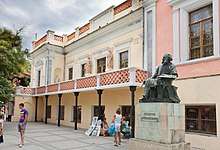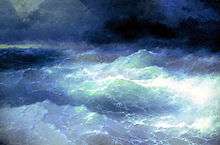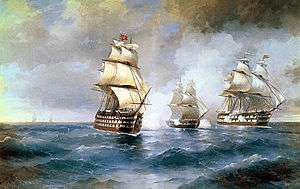Aivazovsky National Art Gallery
The Aivazovsky National Art Gallery is a national art museum in Feodosia, Crimea. The first exhibition was privately organised by Ivan Aivazovsky's in his house in 1845. The basis collection included his 49 paintings. In 1880 an additional exhibition hall was attached to the house. The gallery became the third museum in the Russian Empire, after the Hermitage Museum and the Tretyakov Gallery. After Aivazovsky's death in 1900, the ownership of the gallery was transferred to the city according to his testament.
 | |
.svg.png) Location in Crimea | |
| Established | 1845 |
|---|---|
| Location | Feodosia |
| Coordinates | 45.032175°N 35.382736°E |
| Type | national art museum |
Towards the end of 1920, the house was occupied by the Feodosia department of Cheka. Several paintings were damaged at that time.
Since 1922, the gallery became a state museum in the USSR. The collection consists of about 12 thousand nautical theme works, including the world's largest collection of works by Ivan Aivazovsky himself (417 paintings). The gallery exposition introduces the works of Aivazovsky, his family history, and the history of the gallery. A separate building (artist's sister house) presents mythological and biblical paintings, foreign marine paintings of the 18th-19th centuries, and the Cimmerian school of painting including Maximilian Voloshin, Lev Lagorio, Konstantin Bogaevsky, Mikhail Lattry, Adolf Faessler, and Arkhip Kuindzhi.
In 1930 a monument to Aivazovsky, by Ilya Ginzburg, with the inscription "Feodosia to Aivazovsky" was erected in front of the main building.
Gallery
| Wikimedia Commons has media related to Aivazovsky gallery in Feodosia. |
 Aivazovsky self-portrait, 1881
Aivazovsky self-portrait, 1881 Among the Waves, 1898
Among the Waves, 1898
.jpg) Sea coast, 1868
Sea coast, 1868- Italian Landscape Lago Maggiore in the Evening, 1858
- Battle of Çesme at Night, 1848
References
- С. Р. Гриневецкий, И. С. Зонн, С. С. Жильцов. Черноморская энциклопедия. — М.: Международные отношения, 2006. — 35 c. — ISBN 5-7133-1273-9 (in Russian).
- Феодосия: краткий путеводитель. Редакторы А. В. Меснянко, Ю. С. Воронцова. — Севастополь: Библекс, 2007. — 96 с. — ISBN 978-966-8231-93-3 (in Russian).
- Aivazovsky National Art Gallery. The guide. Simferopol, 1971.
